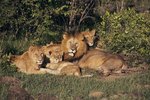
A silverback gorilla is the mature, experienced male leader of a group of mountain gorillas in the wild. Named for the silver saddles across his back, the silverback is responsible for the safety of his group. A group of gorillas, also called a “troop,” can contain from 5 to 30 gorillas. The silverback decides where the troop travels, where it forages for food, where it will rest and where it will sleep at night.
Physical Description
Silverbacks are very large. When they stand upright, they are from 5.5 to 6 feet tall and weigh as much as 350 pounds. Females typically are no taller than 5 feet and weigh as much as 200 pounds. The silverback's ears look small for its head. Males have a large bony crest on the tops of their skulls and back, which helps support their jaw muscles and teeth. The bony crest gives their heads a conical shape. Females have the same crest as well, but it is not as pronounced as it is in males. Silverbacks also are very hairy; they are the hairiest of all gorilla species. Their hair is long and thick, and helps to insulate them at high elevations. Their arms are shorter than the arms of lowland gorillas, and their legs are short in comparison to their arms. Silverbacks get their silver saddle at around 12 years old. Younger males who don't yet have the silver saddle are called "blackbacks."
Characteristics
Despite their formidable size and strength, mountain gorillas are quite gentle and even shy. They are very social animals, but within their own tight-knit, nomadic troops. They show each other affection, often hugging and playing with each other, much like humans do. Also like humans, mountain gorillas laugh and even throw things when they get angry. Although they typically are peaceful, younger males from other troops may challenge a silverback. To ward off unwanted gorillas, the silverback will beat his chest with cupped hands, scream and bare his teeth, and charge at the intruder. Silverbacks also may break off branches from a tree and shake them at intruding gorillas.
Distribution
Western lowland gorillas are found in Nigeria, Cameroon, Equatorial Guinea, Gabon, the Republic of Congo, the Democratic Republic of Congo and Angola. They are also found in the Central African Republic. Both Eastern lowland and mountain gorillas live in the DRC, Rwanda and Uganda.
Diet
Gorillas are primarily vegetarians, and feed along the edges of dense forests. However, they do eat whatever insects and small animals are on the leaves and stems they consume. Gorillas also will eat crops and rotting wood. Silverbacks consume 45 pounds of food every day.
Mating
The silverback is the only male in a troop who gets to mate with the troop’s females. The females choose him for his size and strength. Sometimes the silverback will allow other mature males in his troop to mate with one of the females. Males tend to leave the troop when they reach sexual maturity, and travel alone for some time until they eventually form their own troops to head.
References
Photo Credits
-
Jupiterimages/Photos.com/Getty Images
Writer Bio
Vivian Gomez contributes to Retailing Today, the Daily Puppy, Paw Nation and other websites. She's covered the New York Comic Con for NonProductive since 2009 and writes about everything from responsible pet ownership to comic books to the manner in which smart phones are changing the way people shop. Gomez received her Bachelor of Arts in English literature from Pace University.



